Lead Generation For Plastic and Aesthetic Surgeons
How to get maximum surgery patients for your plastic surgery center? The best way to do it is through an integrated search marketing strategy.
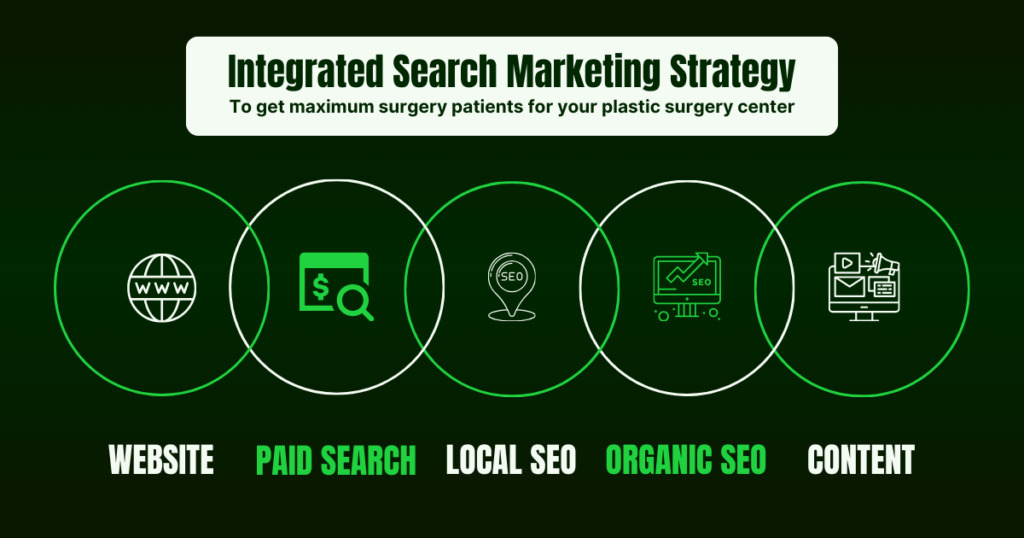
This powerful approach combines several marketing tactics to cover all aspects of the search engine results page (SERP). This plastic surgery marketing guide rate integrated search marketing as the best strategy for plastic surgery marketing.
But why is this the best strategy? It’s simple. It targets all the key areas of SERP. From paid ads to local SEO, it boosts your online presence. This makes it easier for patients to find and choose your surgery center.
When people search for plastic surgeon, you want your center to stand out. An integrated strategy does just that.
Imagine your website popping up first when someone searches for a plastic surgeon in your area. Think about the impact of showing up in local listings, paid ads, and organic search results. This is what integrated search marketing can do for you.
let’s first understand the google search journey that surgery patients take.
Don’t have time to read it all?
Download it now and save it for later
Understanding the Google Search Journey of Surgery Patients
When someone decides to get plastic surgery, their journey often starts with a Google search. They might search for “best plastic surgeon near me” or “top-rated plastic surgery center in Beverly hills.”
During this search, patients are looking for more than just names and addresses. They want to see reviews, check out websites, and compare options. This is where their psychological behavior comes in. They’re looking for reassurance and trust. They want to see proof that they’re making the right choice.
The google search results plays a huge role in this. It shows different types of content: paid ads, local listings, organic search results, and even review snippets. Each part of the SERP offers a chance to catch a patient’s eye and build trust.
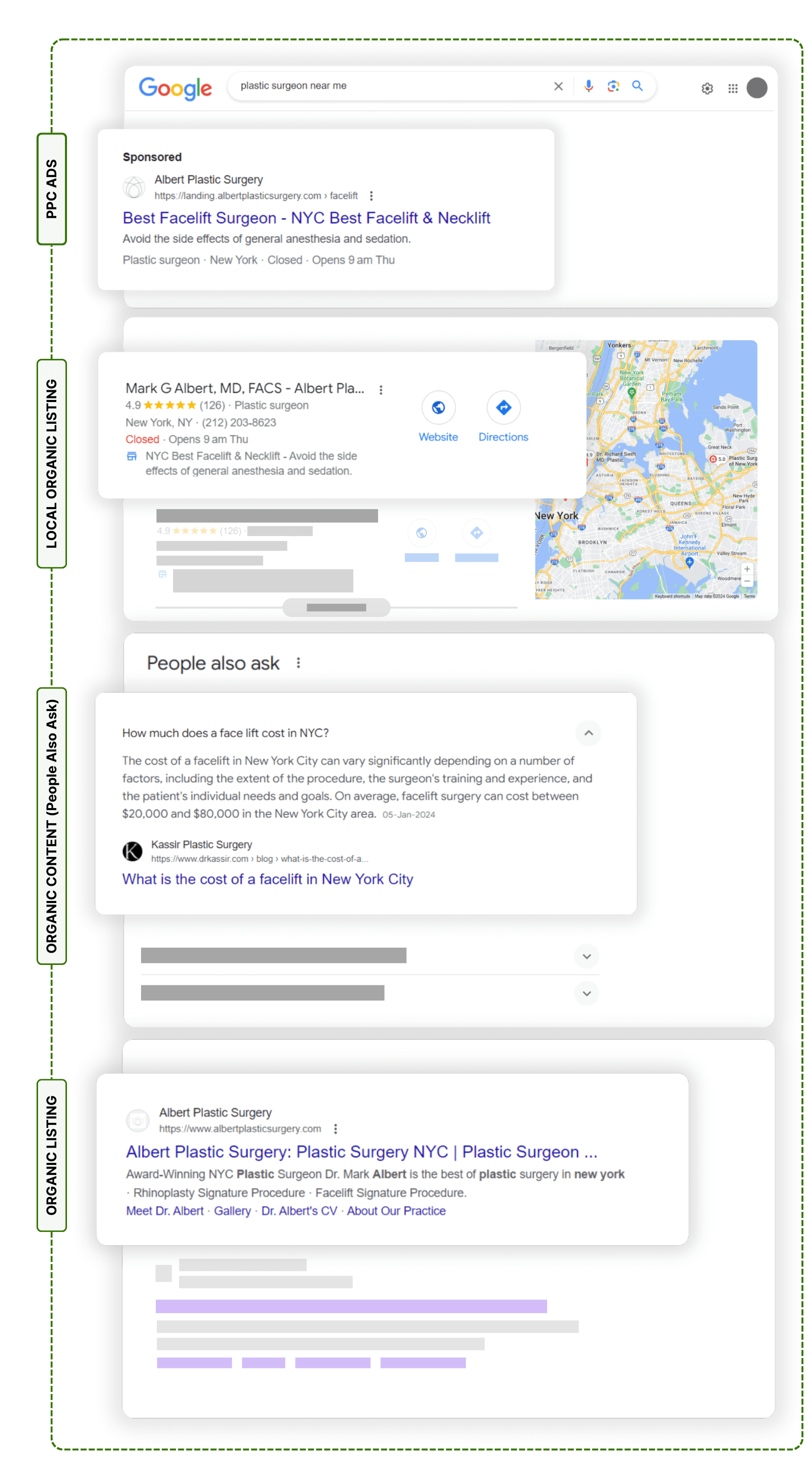
An integrated search marketing strategy helps you target all these aspects. It ensures that your practice shows up in paid ads, local SEO, and organic results. This comprehensive approach maximizes your chances of attracting patients at every stage of their search journey.
Why does this work so well for plastic surgery marketing? Because it covers all the bases. From the moment a potential patient starts their search to the moment they choose a surgeon, an integrated approach makes sure your surgery center is visible and appealing.
Isn’t that what every surgeon wants?
Next, we’ll dive into how to best implement this strategy to get the most surgery patients for your center. Ready to learn how?
How to best implement Integrated search marketing strategy
Correct implementation of integrated search marketing strategy is crucial to get the desired results.
We’ll guide you step-by-step to ensure you can do it too.
Here’s how we do it at 10X WEBGRO.
Step 1: Website creation and optimization
Without a website or a landing page, its technically impossible to rank on google search result page.
Website is the starting point of integrated search marketing strategy. It’s where potential patients first interact with your surgery center.
A great plastic surgery website design builds trust and provides the info patients need to choose you. Without a strong website, other marketing efforts won’t work as well.
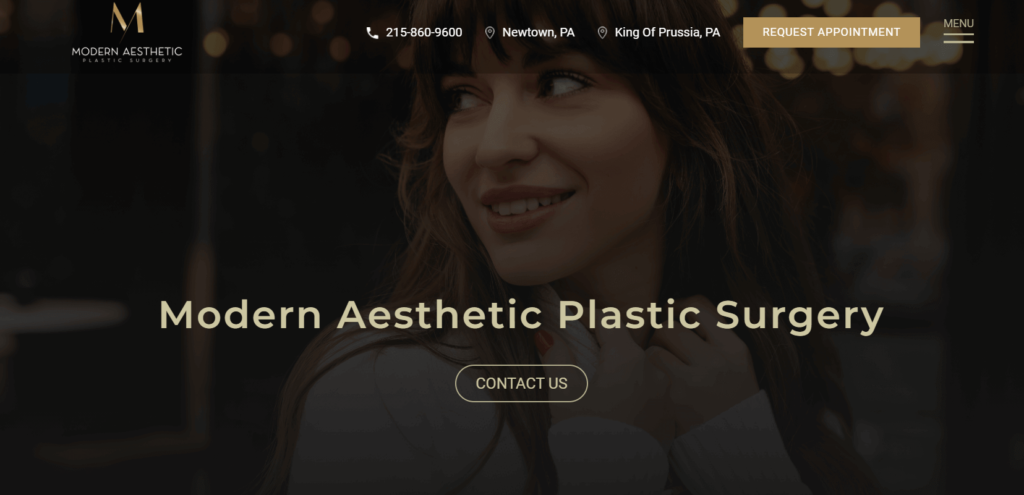
A well-optimized website drives more traffic and keeps visitors engaged. It’s crucial for plastic surgery marketing because it turns clicks into consultations. By optimizing for search engines and user experience, you increase your chances of ranking higher on Google, which means more patients finding you.
Why miss out on patients because your site isn’t up to par?
Here is a process we recommend you follow:
- Choose the Right Web Hosting: Start by selecting a reliable web hosting service. A good host ensures your site is fast and always online. This is the technical foundation of your plastic surgery website.
- Expert Web developers: To create a professional website, you need expert web developer. Our developers at 10X WEBGRO specialize in plastic surgery website design, ensuring it meets industry standards and patient expectations.
- Industry-Specific Design: Every industry has unique needs. A plastic surgery center’s website should include specific pages like service descriptions, before-and-after galleries, and patient testimonials. This targeted approach helps you connect better with potential patients.
- Branding Alignment: Your website should reflect your surgery center unique value proposition. Use consistent colors, fonts, and messaging that align with your surgery center’s branding. This creates a cohesive look and builds trust with potential patients.
- Website Created: Once your website initial layout is created, it’s time to optimize it for conversions. This means making it easy for visitors to book consultations, contact you, or learn more about your services. Clear calls-to-action (CTAs) are essential.
- Optimize Pages for Traffic: Every page should be optimized for search engines and user experience. Use SEO best practices like keyword-rich content, meta tags, and alt text for images. This helps your site rank higher on Google and attract more visitors.
- Conversion Landing Page: Create specific landing page for traffic from different sources. Whether it’s from paid ads, organic search, or social media, your conversion landing page should be designed to convert visitors into patients.
- Mobile Optimization: Ensure your website works well on all devices. Many patients will visit your site from their phones or tablets, so it needs to be mobile-friendly. Responsive design adjusts your site layout to fit any screen size.
- Targeted Content: Tailor your website content to your ideal patients requirements. This means creating pages and blog posts that address their specific needs and concerns. Content will help you rank in snippets, PAA, and organic results.
- Regular Updates: Keep your website fresh by regularly updating it with new content and features. This shows that your surgery center is active and current, which can build trust with potential patients.
Step 2: Paid search ads
Paid search ads are a crucial part of an integrated search marketing strategy because they put your practice at the top of Google search results, right where potential patients are looking. This visibility drives traffic and leads directly to your website.
Paid search ads are highly targeted, allowing you to reach people actively looking for plastic surgery services. They offer measurable results, enabling you to see which ads are driving clicks and conversions.
Plus, they provide quick results, making them an essential part of a comprehensive plastic surgery marketing strategy.
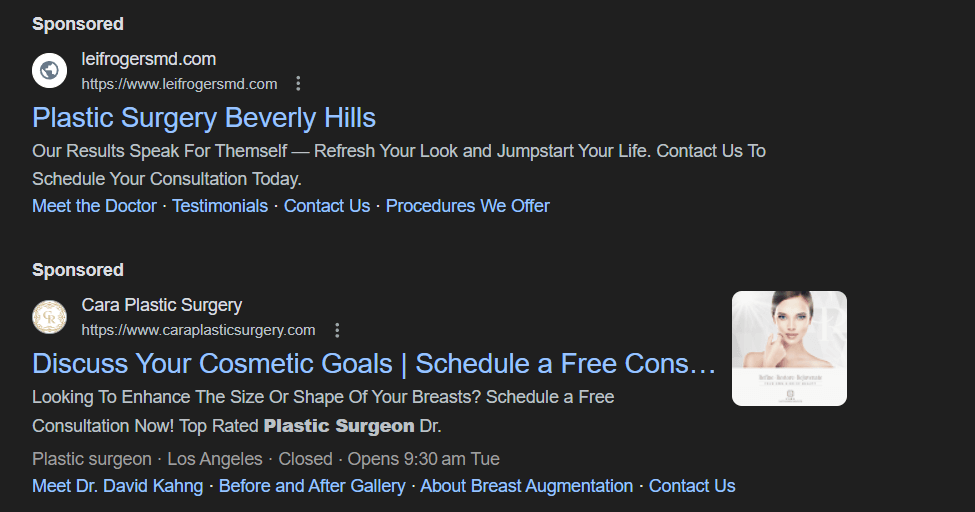
Paid search ads are not just an expense; they are an investment. The money spent on these ads will bring a return on investment (ROI) by attracting more patients to your practice. This targeted approach in plastic surgery marketing ensures you see tangible results from your ad spend.
Our Recommended Paid search ads Process:
- Optimized Conversion Landing Page: Your optimized landing page is the foundation for a successful ad campaign. Ensure it’s designed to convert visitors into patients with clear calls to action, easy navigation, and relevant information.
- Keyword Research: Identify the keywords potential patients use to find plastic surgery services. Tools like Google Keyword Planner can help you discover high-volume, low-competition keywords to target.
- Ad Copywriting: Craft compelling ad copy that grabs potential patients attention and encourages clicks. Highlight unique selling points, such as special offers or patient testimonials. Keep it concise and focused on the benefits of choosing your surgery center.
- Setting Up a Google Ad Campaign: Create your ad campaign in Google Ads. Set your budget, choose your target audience, and configure your ad groups based on your keyword research. Make sure your ads are linked to your optimized landing page.
- A/B Testing: Run A/B tests to determine which ads perform best. Test different keywords, headlines, ad copy, and call-to-action buttons. Use the results to refine your ads and improve their effectiveness over time.
- Scaling Successful Keywords: After A/B testing, identify the best-performing keywords. Scale your ad spend on these high-performing keywords to maximize your reach and ROI. This step ensures you are putting your budget where it will bring the most patient traffic and conversions.
- Ad Extensions: Use ad extensions to provide additional information and increase the click-through rate of your ads. Include site links, call extensions, and location extensions to make your ads more informative and attractive. Ad extensions enhance the visibility and functionality of your ads on the SERP.
- Monitoring and Optimization: Regularly monitor your ad performance and make necessary adjustments. Analyze metrics like click-through rates, conversion rates, and cost per conversion. Optimize your bids, keywords, and ad copy based on performance data to ensure your campaign remains effective and efficient.
Step 3: Local SEO
Local SEO means optimizing your online presence to attract more business from relevant local searches.
For plastic surgeons, this means being visible in Google My Business (GMB), Google Maps, and local search results. This visibility is crucial because most patients search for surgeons nearby.
When your practice shows up in these local searches, it significantly increases your chances of being chosen by potential patients.
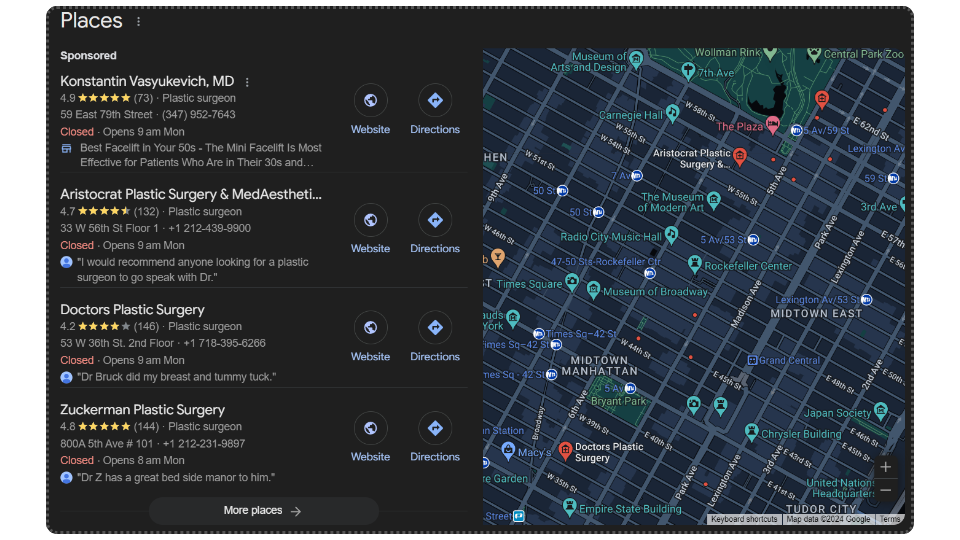
The main purpose of local SEO is to make sure your surgery practice is found by people searching for services in your area.
Local SEO helps you rank higher in local searches, driving more traffic to your website and bringing more patients through your doors. By optimizing for local SEO, you can capture this valuable traffic and turn searchers into patients.
Local SEO Process We Recommend You Follow:
- Complete GMB Profile: Having a complete and accurate GMB profile is the first step in local SEO. Here’s how you can do it:
- Claim Your Business: If you haven’t already, claim your business on Google My Business.
- Verify Your Listing: Google will send you a postcard with a verification code to confirm your address.
- Fill Out All Details: Ensure your business name, address, phone number, and website are accurate and consistent.
- Add Business Hours: Include your hours of operation so patients know when you’re available.
- Select Categories: Choose relevant categories like “Plastic Surgeon” to help Google understand what your business is about.
- Add Cover Photo: Adding a cover photo helps your practice stand out. Use a high-quality image that represents your brand and practice well. This image will be the first thing potential patients see, so make it professional and inviting.
- Get Reviews: Reviews are crucial for local SEO. Encourage happy patients to leave positive reviews. Positive reviews not only boost your ranking but also build trust with potential patients.
- Build Local Citations: Local citations are online mentions of your practice’s name, address, and phone number. Ensure your practice is listed in local directories like Yelp, Healthgrades, and Yellow Pages. Consistency is key; make sure your information is the same across all platforms.
- Consistently Optimize GMB: Regularly update your GMB profile to keep it fresh and relevant. Post updates about new services, promotions, or important announcements. Respond to reviews—both positive and negative—to show that you value patient feedback. Consistent optimization keeps your practice visible and engaging.
Step 4: Organic SEO
Organic SEO (Search Engine Optimization) involves optimizing your website to rank higher on search engines like Google. It’s crucial because it ensures your practice appears in relevant searches, driving organic traffic to your site.
Organic SEO focuses on both on-page and off-page tactics to improve your site’s visibility and ranking.
Organic SEO is essential for appearing in Google search results. When people search for plastic surgery services, you want your practice to be at the top. This not only increases visibility but also builds trust with potential patients.
Google’s algorithm favors well-optimized sites, making SEO a key component of plastic surgery marketing.
The purpose of Organic SEO is to increase your website’s organic traffic by improving your search engine ranking. For plastic surgery centers, this means more visibility to potential patients.
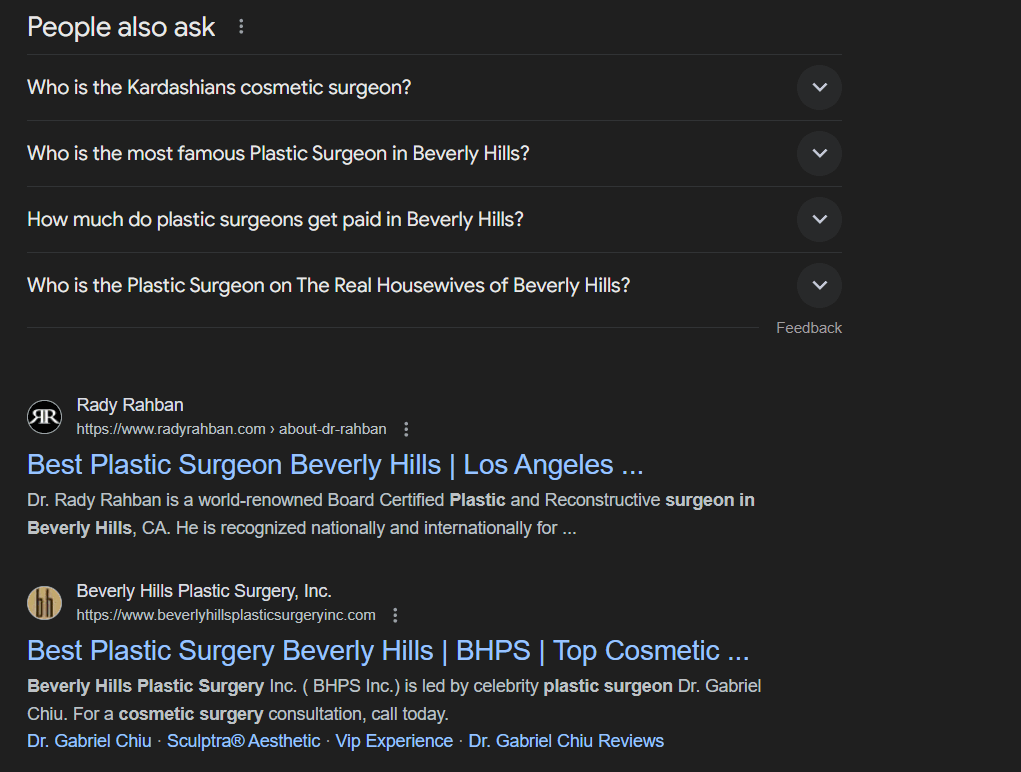
Effective SEO leads to higher rankings, more clicks, and more consultations. By investing in SEO for plastic surgeons, you can achieve long-term growth and patient acquisition.
While implementing our integrated search marketing strategy, we work on Organic SEO simultaneously with other tactics like local SEO and paid search ads. This holistic approach ensures all aspects of your online presence are optimized, maximizing your reach and effectiveness.
Here’s the Important SEO checklist you Can perform:
Technical SEO Using Tools: Technical SEO involves optimizing your website’s backend to ensure it’s easily crawled and indexed by search engines. Using tools like Google Search Console and PageSpeed Insights, we identify and fix issues that could hinder your site’s performance.
- Site Speed: Ensure your website loads quickly. Slow sites can lead to higher bounce rates and lower rankings. Tools like PageSpeed Insights help identify elements that need improvement.
- Mobile Optimization: With more people using mobile devices to search, your site must be mobile-friendly. Use responsive design to ensure your site looks good on all devices.
- Fixing Errors: Use Google Search Console to find and fix crawl errors, broken links, and other issues that could affect your site’s ranking.
By optimizing these technical aspects, you ensure that search engines can easily access and understand your site, improving your overall SEO performance.
On-Page SEO: It involves optimizing individual pages on your website to rank higher and earn more relevant traffic. This includes optimizing content, titles, and meta descriptions.
- Content Optimization: Ensure your content is relevant, informative, and uses targeted keywords like “plastic surgery in nyc and “best aesthetic surgeon in beverly hills” High-quality content keeps visitors on your site longer and encourages them to explore more.
- Titles and Meta Descriptions: Optimize your titles and meta descriptions to include your main keywords. This helps search engines understand what your page is about and improves click-through rates from search results.
- Internal Linking: Link to other relevant pages on your site. This not only helps visitors navigate your site but also helps search engines crawl and index your content better.
Optimizing these elements ensures that each page on your site is fully optimized for search engines, improving your overall search visibility.
Off-Page SEO: It involves actions taken outside your own website to impact your rankings within search engine result pages (SERPs). This primarily involves building backlinks from other websites to yours.
- Building Backlinks: Reach out to authoritative sites in your industry and ask them to link back to your content. Backlinks act as votes of confidence from other sites, improving your site’s credibility and ranking.
- Guest Posting: Write articles for other websites in plastic surgery industry. This not only builds backlinks but also establishes you as an authority in your field.
Building a strong backlink profile is essential for improving your site’s authority and ranking in search results.
Step 5: Content marketing
Content marketing for plastic surgeons is crucial for both Google search and your website. By creating valuable content, you help your site rank higher in search results, attract more potential patients, and convert them into consultations.
This is especially important for plastic and aesthetic surgery centers, where potential patients often conduct extensive research before making decisions.
Content marketing is closely tied to keywords, SEO, and SERP rankings. Using targeted keywords like “top aesthetic surgery procedures” and “cosmetic surgery procedures” in your content helps search engines understand what your pages are about.
This improves your chances of appearing in featured snippets, People Also Ask (PAA) sections, and even the #1 position in search results. The better your content, the more likely it is to rank well and qualified leads to your site.
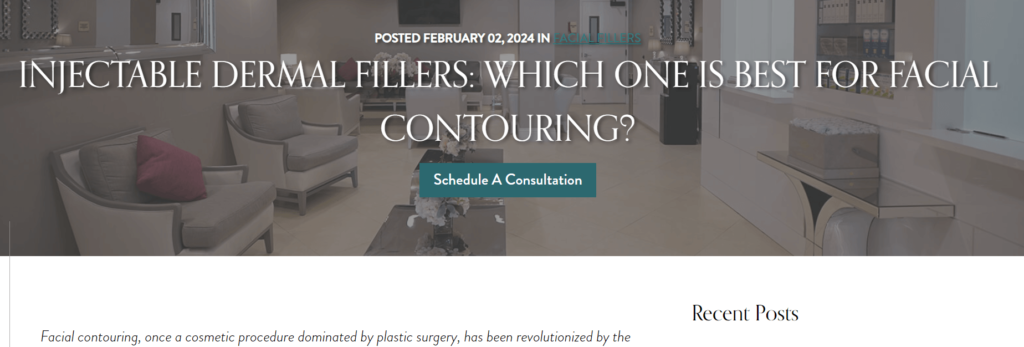
Why is content marketing so important for plastic surgeons? It helps potential patients with their research and search. High-quality content answers their questions, builds trust, and positions your practice as an authority.
What types of content work best for plastic surgery centers? Here are a few:
- Blog Posts: Regularly updated blog posts that address common questions and concerns are a great way to attract visitors. They also help with SEO by targeting specific keywords.
- Patient Testimonials: Real-life stories from satisfied patients build trust and credibility. These can be in text or video format.
- Before-and-After Galleries: Visual content showcasing your work is very effective. Potential patients want to see the results they can expect.
- Educational Videos: Videos explaining procedures, recovery times, and what to expect can be very engaging.
- FAQs: A comprehensive FAQ section can address many common concerns, helping to reduce the number of inquiries and providing quick answers.
Using these content types ensures that you are providing valuable information that potential patients are looking for. By implementing a robust plastic surgery content marketing strategy, you not only improve your search rankings but also build a strong relationship with your audience.
This is the process we follow and we recommend you the same process:
Content Planning: The first step in our process is content planning. This involves researching what potential patients are searching for and identifying the topics that will best address their needs. Also you need a content calendar to plan your content properly.
- Content Creation: Once you have a plan, it’s time to create the content. The key is to create high-quality, engaging content that addresses the needs and concerns of your potential patients. Great content helps build trust and positions you as an authority in the field of plastic surgery.
- Content Publishing: Publishing your content is the next step. Make sure to publish regularly to keep your website fresh and engaging. Use a consistent schedule so your audience knows when to expect new content.
- Content Promotion: Creating great content is just the beginning. You also need to promote it. Share your content on social media, in email newsletters, and through other channels to reach a wider audience. The more people who see your content, the more likely you are to attract new patients.
- Content Management: Finally, it’s important to manage your content. This means regularly updating old content to keep it relevant, monitoring your website analytics to see what’s working, and making adjustments as needed.
By following these steps, you can create a powerful plastic surgery content marketing strategy that attracts and retains patients. Remember, great content isn’t just about filling your website with information—it’s about providing real value to your audience.
So, ask yourself, what questions do your potential patients have, and how can your content answer them?
Results from Using Integrated Search Marketing Strategy
Why does Integrated search marketing strategy work best? It helps you dominate the search results and assists surgery patients in their research journey. By covering all aspects of search marketing, from paid ads to content creation, you ensure your surgery center is visible wherever patients are looking.
How does this strategy generate results? It drives more traffic to your website, increases patient inquiries, boosts consultation bookings, and ultimately brings in more surgery patients. By being visible in all key areas of the search results, you’re always where your potential patients are looking.
Our clients have seen incredible results with an average increase of 207% in total consultations. For example, one client saw a 700% increase in website traffic and a 250% increase in consultation bookings within six months of implementing our integrated search marketing strategy. These numbers show just how powerful an integrated approach can be.
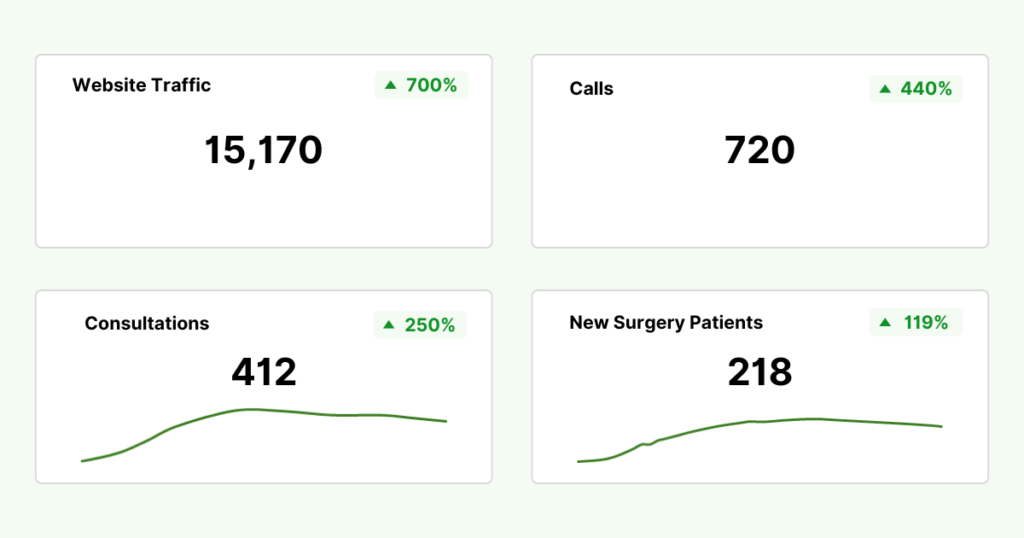
Would it work for you? You need expert advice to tailor the strategy to your specific needs. That’s where 10X WEBGRO comes in. We have the expertise to customize and implement a strategy that will bring you the best results through integrated search marketing strategy.
Not only does this strategy substantially reduce marketing costs, but it also generates a much higher ROI. By focusing on the most effective channels, you get the best bang for your buck, attracting more patients, and growing your surgery center efficiently.
Like Surgery, Plastic Surgery Marketing is Best Left to the Experts
Plastic surgery marketing is different from other types of marketing. It requires a deep understanding of the industry, patient behavior, and the competitive landscape. Just like you wouldn’t trust a general practitioner to perform surgery, plastic surgery marketing should be handled by specialists.
You already have a lot on your plate with running a surgery center and performing surgeries. Marketing is not the best use of your time. By letting plastic surgery marketing experts handle it, you can focus on what you do best and enjoy your life.
At 10X WEBGRO, we specialize in plastic surgery marketing. We know how to attract more patients to your center, allowing you to grow your center without the stress of managing your marketing efforts.
Schedule a call with us and let us show you how we can help you get more surgery patients.

